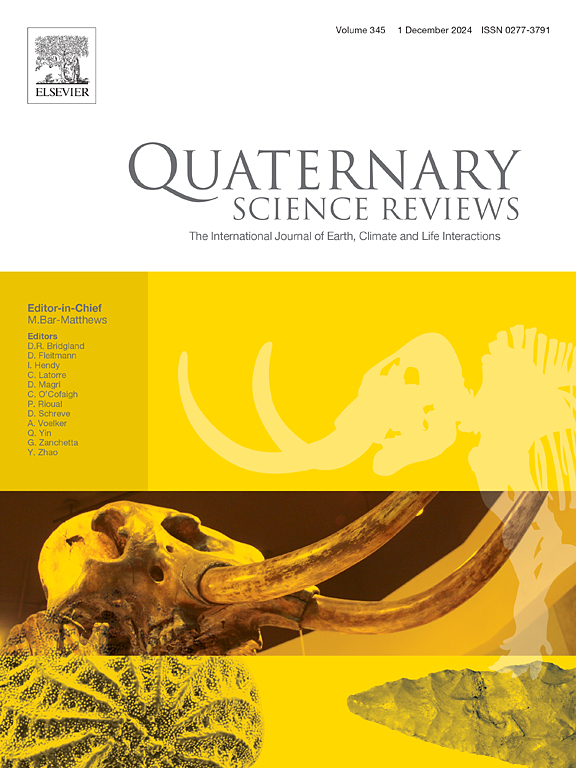新的正构烷烃记录揭示了末次冰期以来华南大湖沼泽有机质来源和季风水文气候变化
IF 3.2
1区 地球科学
Q1 GEOGRAPHY, PHYSICAL
引用次数: 0
摘要
复杂多变的季风气候的长期演变尚未得到很好的理解。华南地区相对封闭的大湖沼泽为古气候和古环境条件的重建提供了有利的背景。本研究为探索东亚季风区南部有机质聚集、水文气候变化及其驱动机制提供了新的正构烷烃记录。16.2 kyr长正构烷烃记录呈现单峰和双峰分布模式,以长链正构烷烃为主(52.0% ~ 92.4%),表明有机质输入主要来源于陆生高等植被和新兴植物。在同一地点已有的代用记录的支持下,正构烷烃表明泥炭沉积物主要发育在寒冷/干燥的条件下,这不利于大型水生植物的生长,降低了微生物的活性,有利于外源陆源有机质的保存。相反,温暖/潮湿间隔表现出相反的趋势。正构烷烃还记录了长达数百年的干旱事件,这些事件与高纬度气候过程和低纬度海洋-大气相互作用有关,这些相互作用影响着东亚季风。进一步的周期分析确定了千禧年(~ 2200年)和百年周期(~ 430年、520年和640年),说明了太阳辐射和活动对东亚季风长期发展的影响。该研究有助于深入了解东亚季风区有机质输入和水文气候变化的动力学,并强调了正构烷烃的特殊见解。本文章由计算机程序翻译,如有差异,请以英文原文为准。
Novel n-alkanes records reveal organic matter sources and monsoon hydroclimatic changes in Dahu Swamp in South China since the last deglaciation
The long-term evolution of complex and variable monsoon climate has not been well understood. The relatively closed Dahu Swamp in South China presents an advantageous setting for reconstruction of the paleoclimate and paleoenvironmental conditions. This study provides novel n-alkanes records to explore the accumulation of organic matter, hydroclimate changes, and driving mechanisms in the south of the East Asian monsoon region. A 16.2-kyr long n-alkanes record exhibits both unimodal and bimodal distribution patterns, with long-chain n-alkanes dominating (52.0–92.4 %), indicating that the organic matter inputs are chiefly sourced from terrestrial higher vegetation and emergent plants. With the support of previously published proxy records from the same site, the n-alkanes reveal that peat sediments are mainly developed during cold/dry conditions, which are not conducive to the growth of large aquatic plants, reduce microbial activity, and are favourable to the preservation of exogenous terrestrial organic matter. Conversely, warm/humid intervals exhibit opposite trends. The n-alkanes also document drought events, several hundred years long, which are associated with high-latitude climatic processes and low-latitude ocean-atmosphere interactions that affect the East Asian monsoon. Further periodic analysis allowed the identification of millennial (∼2200 yr) and multi-centennial cycles (∼430 yr, 520 yr, and 640 yr), illustrating the influence of solar radiation and activity on the long-term development of the East Asian monsoon. This study contributes to a deeper understanding of the dynamics related to organic matter input and hydroclimatic changes in the East Asian monsoon region, and emphasises the particular insight from the n-alkanes.
求助全文
通过发布文献求助,成功后即可免费获取论文全文。
去求助
来源期刊

Quaternary Science Reviews
地学-地球科学综合
CiteScore
7.50
自引率
15.00%
发文量
388
审稿时长
3 months
期刊介绍:
Quaternary Science Reviews caters for all aspects of Quaternary science, and includes, for example, geology, geomorphology, geography, archaeology, soil science, palaeobotany, palaeontology, palaeoclimatology and the full range of applicable dating methods. The dividing line between what constitutes the review paper and one which contains new original data is not easy to establish, so QSR also publishes papers with new data especially if these perform a review function. All the Quaternary sciences are changing rapidly and subject to re-evaluation as the pace of discovery quickens; thus the diverse but comprehensive role of Quaternary Science Reviews keeps readers abreast of the wider issues relating to new developments in the field.
 求助内容:
求助内容: 应助结果提醒方式:
应助结果提醒方式:


